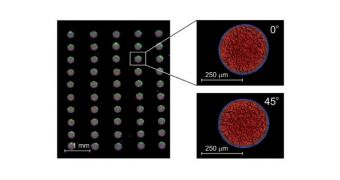A team of investigators at the University of Cambridge announces the development of a method for printing lasers on a wide array of materials, using common inkjet technologies. The achievement could find numerous applications in medicine and electronics, the group believes.
Scientists say that it may be possible to use it for the manufacturing of laser arrays for displays, or for creating biomedical testing devices, to be used in the developed world, where access to doctors is only minimal, and basic medical care is often lacking.
Details of the new investigation were published in the August 24 issue of the esteemed journal Soft Matter. The UK researchers explain how self-assembled photonic structures are the key to this entirely new capability.
Developing the ability to print lasers could advance science considerably, since these light sources are very heavily used in a variety of researches. However, since their manufacturing process is currently very complex, not every scientist who needs a certain type of laser can get one.
Their scientific and industrial uses range from medical treatment and diagnostics to remote sensing for spacecraft surveying other worlds. Despite being so widely used, very little effort has thus far gone into making them easier to produce.
A large part of their manufacturing process is similar to that used for building microprocessors, and involve the use of silicon wafers. With the new approach, the chemical is replaced by chiral nematic liquid crystals (LC). These molecules have a helix-shaped structure.
One of their most important properties is that they can act as optically resonant cavities. After some tinkering, the Cambridge group was able to print LC on a variety of materials, all while still retaining the ability to produce laser light of multiple colors.
The printers used in this research were able to put the LC on flexible materials as well, meaning that you could soon start wearing a laser T-shirt, for whatever purpose that may serve. The Cambridge team points out that only our imagination is the limit to what can be achieved with the new capability.

 14 DAY TRIAL //
14 DAY TRIAL //